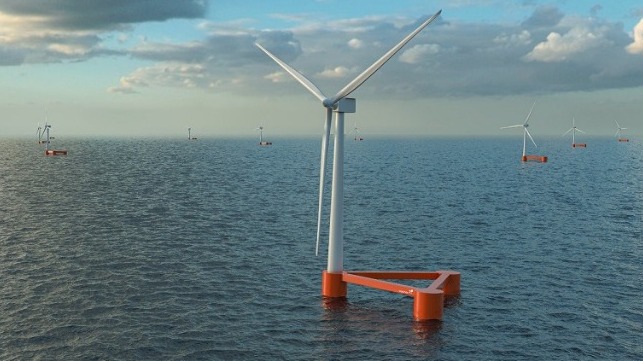Equinor Scraps its Spar Design for Floating Offshore Wind Bid

Norwegian oil major Equinor has unveiled a new floating wind platform design that it will incorporate into its bid for the massive ScotWind offshore lease offering. The design represents a departure from Equinor's unique and well-known Hywind spar platform, which it used for its Hywind Scotland demonstration project.
Equinor's new "Wind Semi" is a standard semisubmersible wind turbine foundation, with three floatation columns connected by steel beams. Illustrations suggest a strong resemblance to other firms' floating-wind designs, like the Principle Power model used at the Kincardine Offshore Wind Farm.
If Equinor is successful in its bid, it plans to install a one gigawatt floating offshore wind farm in a single project. According to Equinor, the new semisubmersible platform has been designed specifically to suit local fabrication and assembly capabilities in Scotland, allowing for more local content.
"By leveraging our twenty years of floating offshore wind experience and innovations, we plan to develop GW-size floating projects in one single phase," says Sonja C. Indrebø, Equinor VP of floating offshore wind. "This project would be over 30 times bigger than Hywind Scotland, the UK’s and Equinor’s first floating project, and [would] have the potential to not only position Scotland as a leader in deep water technology, but also create opportunities for both existing suppliers and new entrants."
In a statement, Equinor listed the technical advantages of its new semisubmersible platform, comparing its virtues with some of the limitations of its earlier spar design.
First, according to the firm, the new platform is more dependable than the Hywind spar. "By introducing a passive ballast system, the Wind Semi has a simple substructure design, reducing the risk of system failure," Equinor said. "[It has] a flat plate design that is free from bracings, heave plates and complicated nodes that are prone to fatigue cracking."
Second, the platform has a shallower draft than the spar, making it easier to assemble and deploy from small ports.
Equinor was the first firm to deploy a floating offshore wind turbine, and it still operates the Hywind Scotland project off the fishing port of Peterhead. Hywind Scotland runs at a higher capacity factor than other wind farms in the UK due to the superior sustained winds found further offshore, according to Equinor.
